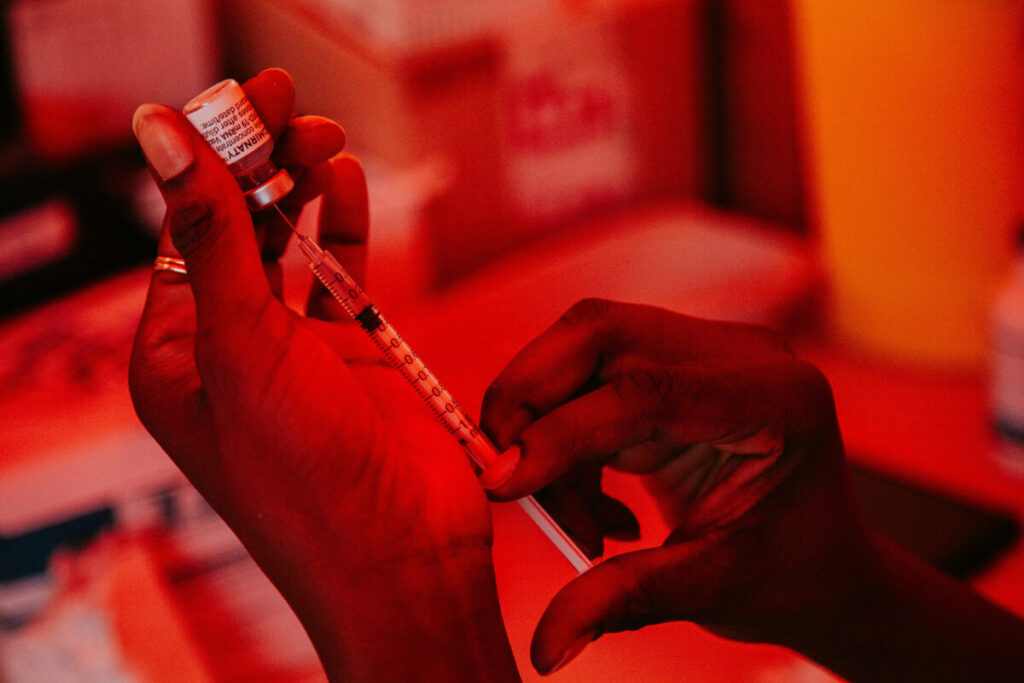By Lori Lee
NDG Contributing Writer
The Centers for Disease Control (CDC) announced this week it is recommending an individual-based vaccine schedule and a separate shot for chickenpox, normally combined with measles, mumps, and rubella vaccines. The advisory has some people and their doctors scratching their heads, as the burden of decision shifts to physicians. States have been creating their own advisory panels while vowing to stick with the science, said Dr. Maurizio Bonacini, clinical professor, University of California San Francisco (UCSF) at a September 26 American Community Media briefing.
Also at the briefing were Dr. Peter Chin- Hong, infectious disease specialist and professor of medicine at UCSF, Dr. Yvonne Bonnie Maldonado, professor of pediatrics and health research and policy at Stanford University, and Dr. Benjamin Neuman, professor of biology at Texas A&M University.
Mumps cause painful swelling of the salivary glands, a headache and a fever. Chickenpox and measles bring a rash and cold-like symptoms. Rubella’s red, splotchy rash is accompanied by fever and a mild headache. Many are unfamiliar with these viruses, as children have been quietly protected from them for decades, said Maldonado.
Yet, these four diseases can all be very serious. Before vaccines, measles caused about 500 deaths and 48,000 hospitalizations per year. Large outbreaks of rubella, last occurring in the 1960s, caused infertility, thousands of miscarriages and congenital rubella in over 20,000 infants, with potential deafness, blindness and heart defects. Finally, varicella, or chickenpox, can lead to shingles later in adulthood.

“Most people don’t think these diseases exist anymore, but they do exist, said Maldonado. We are just protected by vaccines.”
All of them spread very quickly in schools. Yet, the data behind the MMRV vaccine shows over 90% protection after two doses, mainly defending for life.
Some doctors have growing concerns over the billions of dollars it will cost to produce the new, separate vaccines, Dr. Sanjay Gupta suggesting it will likely be the public that ends up footing the bill, MSNBC reported.
The less stressful and equally effective combination vaccine had been the choice for many parents, while others chose separate shots in the first dose to minimize the risk of seizure. Yet, as Maldonado pointed out, febrile seizures resolve on their own and do not cause permanent damage, this after nearly 20 years of monitoring by the medical industry, she said.
Now, due to the spread of misinformation, we have lower vaccination rates after measles had been completely eliminated in the U.S. in 2000. Recently, they have started to reappear, said Maldonado, last year with 191 cases requiring hospitalization, and 99 of those in Texas.
Given current vaccination rates, a 2025 Stanford University modeling study found measles will be a normal circulating virus within five years, and polio within10, said Maldonado, this, though a 5% increase in vaccinations would drastically lower those numbers.
“I think part of the issue is people don’t remember these diseases, or they never saw them,” said Maldonado.
Anti-vax has been around even since Benjamin Franklin, she said, and he regretted it because smallpox killed his son. There is no credible study linking measles or any other vaccines to autism, she reassured, although studies were done in millions of children all over the world. Though studies questioned the use of Thimerosal as a preservative, no link was found, John Hopkins University reported, and autism rates have continued to rise since discontinuance of the preservative.
Last month, President Trump also advocated for the hepatitis B vaccine to be given at age 12 rather than infancy. Trump suggested that since the disease is transmitted sexually, babies do not need it. His statement, dangerously misleading, puts children at risk for a very serious disease, which can lead to cirrhoses, liver failure and cancer. Transmission is most commonly mother-to-child, Bonacini explained, a mother being highly viremic, and a child having no immunity.
Hepatitis B vaccine protection is potent, especially in babies, said Bonacini, 97 percent developing titers after only two vaccines, a Chinese study showed. In the U.S., acute hepatitis B has decreased by 60% as people continue to get vaccinated at a young age. Evidence the vaccine prevents cancer is also very strong, given in the first few months of life, said Bonacini.
Similar concerns surround COVID vaccines, said Dr. Chin-Hong. Many insurance companies will continue to cover mRNA vaccines because they are cost effective. Yet, a growing number of barriers are preventing people from getting it. This includes the common notion that the average case of COVID will apply to everyone. Really, COVID has become two separate diseases, said Chin-Hong. Most people will have some discomfort, but it won’t lead to a hospital visit. For others, “it’s like it’s 2020, and they are not doing well,” he said.
There are four groups who should be concerned, he explained. The first is people 65 and older, regardless of health condition. With about 50,000 deaths from COVID in 2024, the typical patient was 75, with a lot of vaccines early on but failing to get updates in the last year or two.
The second group is pregnant people, he said. Because the immune system gets a little less reactive due to the presence of the baby, a pregnant person is relatively immune compromised regardless of their health. This has resulted in a lot of bad outcomes, warned Chin-Hong, at just 25 or 30 years and with no health problems. We can’t vaccinate under six months, he said. The antibodies must pass through the placenta to protect the unborn baby.
The third group is the very young, he added, with babies under two hospitalized at a similar rate to those 65 and older.
The fourth is people of any age with a comorbidity. These people have a very high risk of COVID, said Chin-Hong, and they need to be reminded every year that their system needs to be reminded.
As Neuman pointed out, inactivity is considered a valid comorbidity. “I see a bunch of people sitting in chairs, he said, and I am also sitting on a chair.”
Added Chin-Hong: “We have to move from a place of seeing that COVID vaccines are not prohibited to one where we actually do recommend it very, very strongly for some people.”
Yet, amidst all the new questions and all the new voices, the new CDC guidelines make getting vaccinated more complicated. Having to talk to a doctor is much harder than just going to Walgreens, said Chin-Hong. About 70% of people drop by the pharmacy to get their shots, while 30 to 40% don’t even have access to a regular doctor. Variabilities in requirements and confusion surrounding vaccines create additional barriers, Chin-Hong said. Plus, the guidelines are vague—What is informed decision-making? he asked.
Alliances are forming across the country, vowing to stick with medical science. This includes a group of West Coast states and Hawaii, some East Coast states, and other states in between, like Illinois and Missouri.
Though so many voices may be confusing, said Chin-Hong, these voices may mitigate what’s coming from others, like the CDC.
The divide is getting bigger because there’s a lot of misinformation out there, added Neuman.
“I think that a lot of what’s going on here is myth-making. There’s a spinning of wonderful stories, or terrible stories, and honestly, a lot of people are gonna get hurt because of it,” he said.
When the Department of Health and Human Services pulled about $500 million awarded for mRNA research, it stopped the work that would have helped treat diseases that are likely only curable by mRNA technology, Neuman said.
Lastly, a recent Kaiser Family Foundation poll may offer hope, finding Americans trust their personal doctors more than the CDC and federal officials, said Chin-Hung. While 80% believe in school vaccine mandates, over 90% still believe in vaccines, he said. Despite changing staff and shifting government policy, it seems most Americans are still looking to science for their answers.




